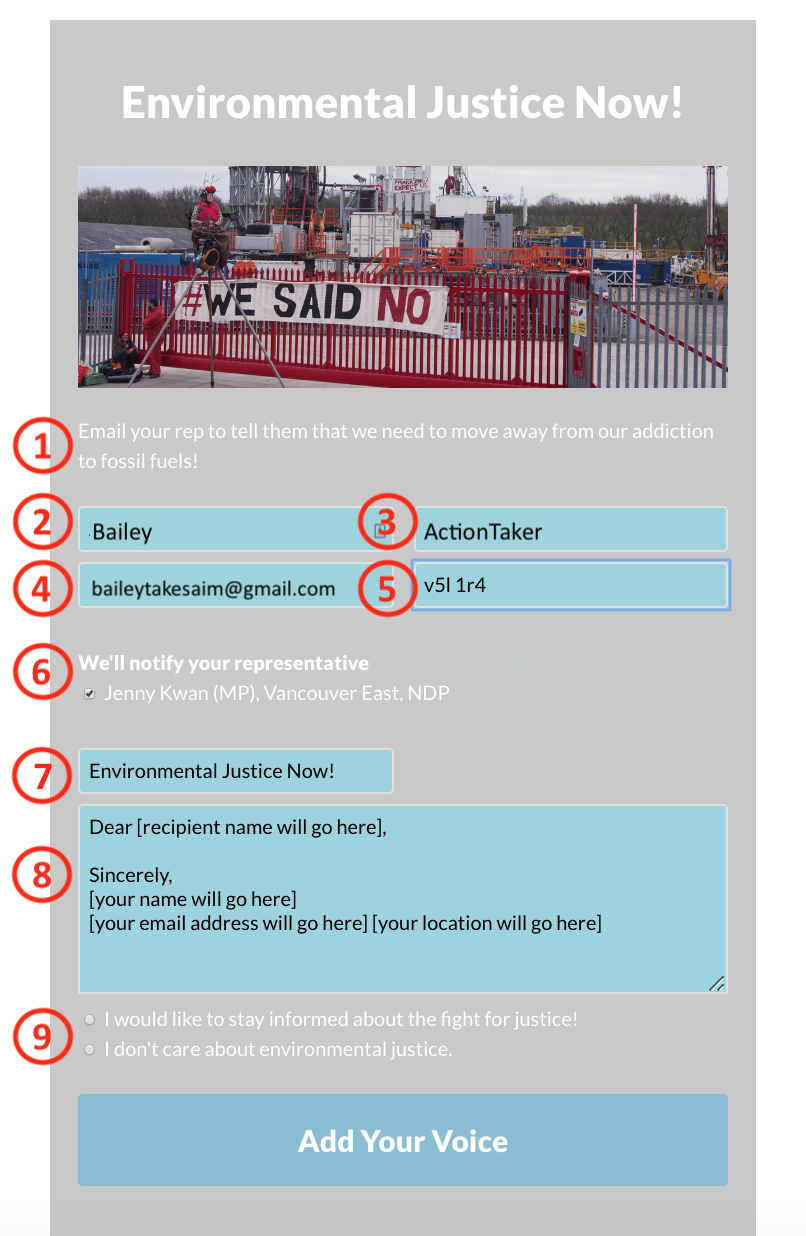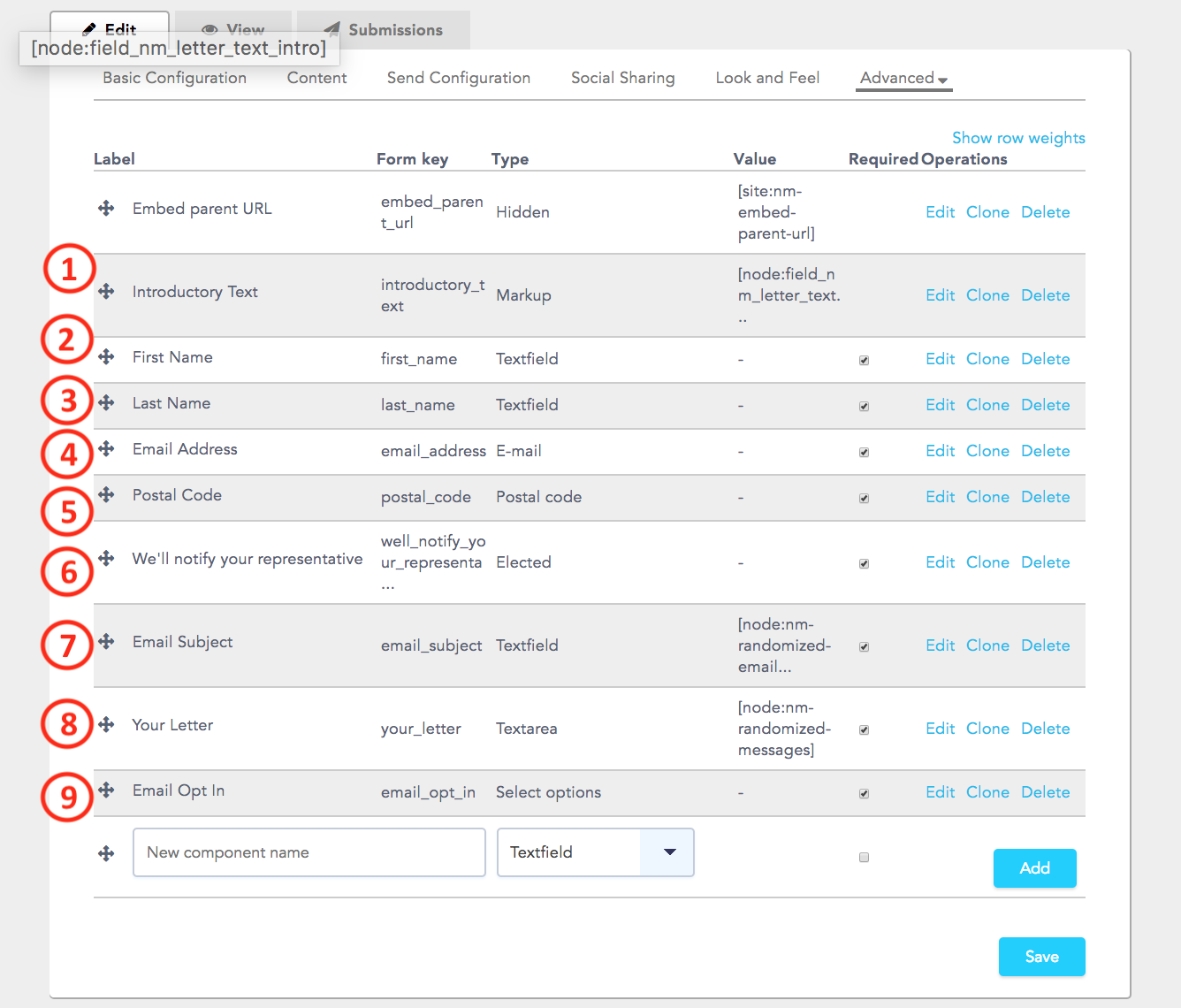Each New/Mode campaign tool is what we call a webform, that is, a form that can be embedded into a webpage. And each form is made up of components, all those building blocks that allow your supporters to interact with your campaign - entering text, clicking buttons, and all that other good stuff.
This feature is available on the Campaign Builder, Organization, and Network plans.
You customize these components under the Edit tab for each campaign tool, but you can also see them all listed in one place on the Components page under Advanced settings.
Here is a brief rundown of how the components you see listed under Advanced settings relate to what you see on the tool:


(0) Embed parent URL: As you can see in the above image, under the component Type column, this is a Hidden component that does not appear on the tool form. It’s the URL associated with the webpage into which you’ve embedded your tool. This always updates automatically and there is no reason to edit it.
(1) Introductory Text: This is the text you configure under Supporter Content on the tool Content page. It’s a Markup component which means it’s static, uneditable text that appears on the tool. If you leave it blank on the Content page, nothing will show up on the form.
(2) First Name: This is a CRITICAL field - certain functions may not work if it gets deleted. On the form, First Name is specified as a required field by default, meaning supporters must enter information into the field in order to submit the form. First Name performs two critical functions for your campaign: (1) many CRMs will not accept synced data that doesn't include a first name; (2) the default templates for One-Click Emails include the first name in the From field of the emails that targets receive and in the signature in the email, and as a salutation in the thank you email.
You can choose to delete the field or make it optional for your supporters, but you will want to ensure you make the necessary changes to the email templates to account for this choice.
(3) Last Name: This is a CRITICAL field - certain functions may not work if it gets deleted. On the form, Last Name is specified as a required field by default, meaning supporters must enter information into the field in order to submit the form. Last Name performs two critical functions for your campaign: (1) many CRMs will not accept synced data that doesn't include a last name; (2) the default templates for One-Click Emails include the last name in the From field of the emails that targets receive and in the signature in the email.
You can choose to delete the field or make it optional for your supporters, but you will want to ensure you make the necessary changes to the email templates to account for this choice.
(4) Email Address: This is a REQUIRED field - certain necessary functions will not work if it gets deleted. Email Address is an Email component type which means it’s tied to the success of the action. Supporters must enter a real email address for the tool to work properly.
(5) Postal/Zip Code/Street Address: This is the field where supporters enter their location information. This is a CRITICAL field - certain functions may not work if it gets deleted. You determine whether they will enter a postal code or street address on the Basic Configuration page when you choose a Target Method. As a Postal/Zip Code/Address component type, this field determines our ability to target the representatives in a supporter's voting area.
We say this field is CRITICAL but not REQUIRED because if your tool is targeting custom targets only, and does not have any location-based lookup function, you may delete this component; but you'll lose the opportunity to collect valuable information about the locations of your supporters.
(6) We’ll notify your representative: This is the field that shows supporters who the tool is targeting. This is a REQUIRED field - certain necessary functions will not work if it gets deleted. You can configure many settings for how the list of targets will display under Optional Settings on the Basic Configuration page. This is an Elected component, meaning that it's tied to our databases of elected representatives. But don't be fooled by the name! When you select Custom Targets on the Basic Configuration page, this component will pull whatever custom targets you provide, including corporate targets. If you are targeting non-elected officials, you can easily change (or hide) the label for this component, by selecting Edit component.
(7) Email Subject: This is the text of the Email Subjects that you configure under Target Content on the tool Content page.This is a REQUIRED field - certain necessary functions will not work if it gets deleted. It’s a Textfield component but it is marked Private by default, meaning it is not visible on the form unless you are logged into New/Mode's backend. If you would like your supporters to be able to see and edit the subject line of their email, you can select Edit next to this component and uncheck Private; however we recommend against this, as more work for your supporters means fewer conversions.
(8) Your Letter: This is the field where your supporters will write their email, and where you may provide a form email by making it uneditable. This is a REQUIRED field - certain necessary functions will not work if it gets deleted. You configure the default content of this email under Target Content on the tool Content page. It’s a Textarea component which allows supporters to enter and edit large amounts of text.
(9) Email Opt In: This component is configured on your Organization Account page under Privacy Settings. If you want to change the message or settings for a particular tool, you can go into Edit component and follow the steps to edit opt-in settings.
At the bottom of each page of the tool form, you'll also see action buttons, which are not listed under Components:

You can find and edit action buttons by navigating to the Form Configuration page under the Advanced settings dropdown menu.
Using Advanced > Components
When you’re working in Advanced components, keep in mind that those all-important REQUIRED components must remain on the form (though you can reconfigure them in various ways)! Beyond these, you have tons of options for reconfiguring and customizing your campaign tool:
- Add additional components, like a supporter image or a dropdown menu.
- Edit components
- Rearrange components
- Rename buttons and labels
